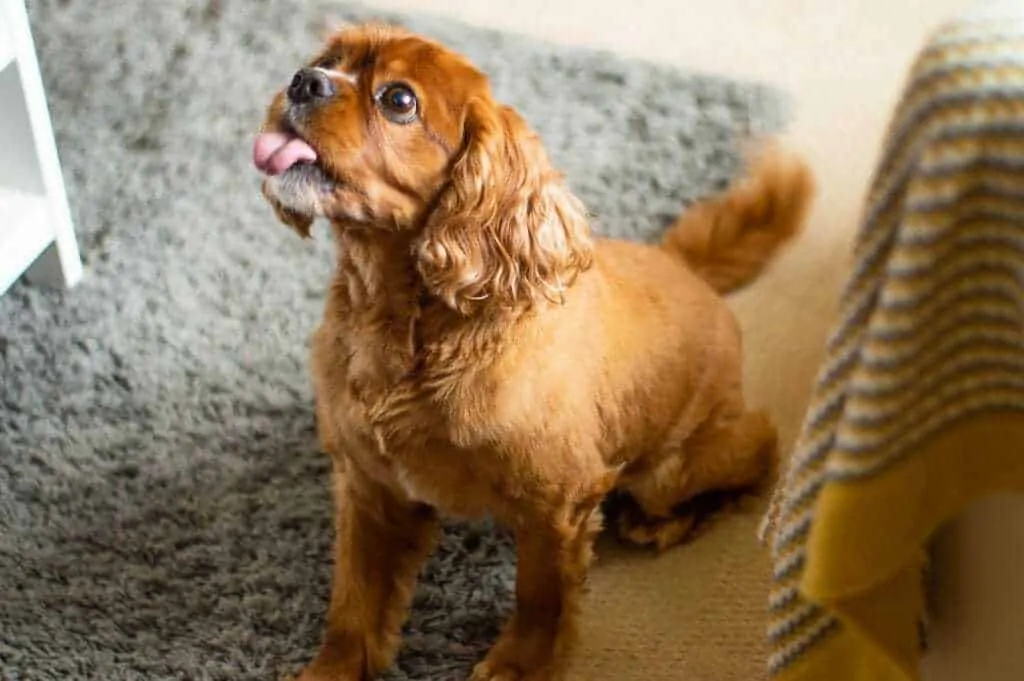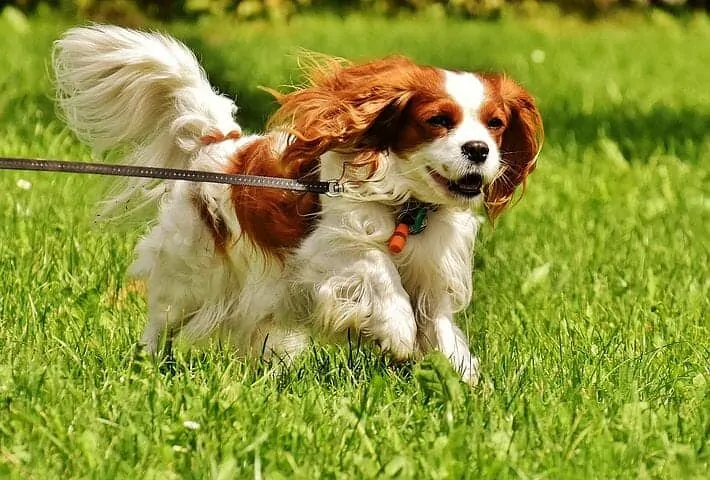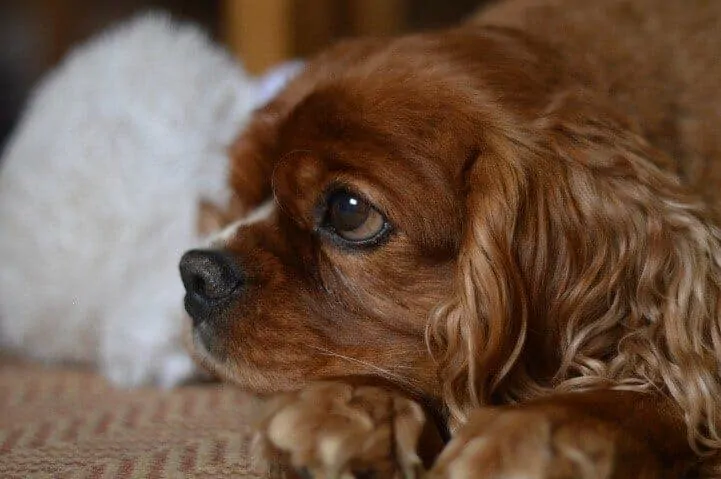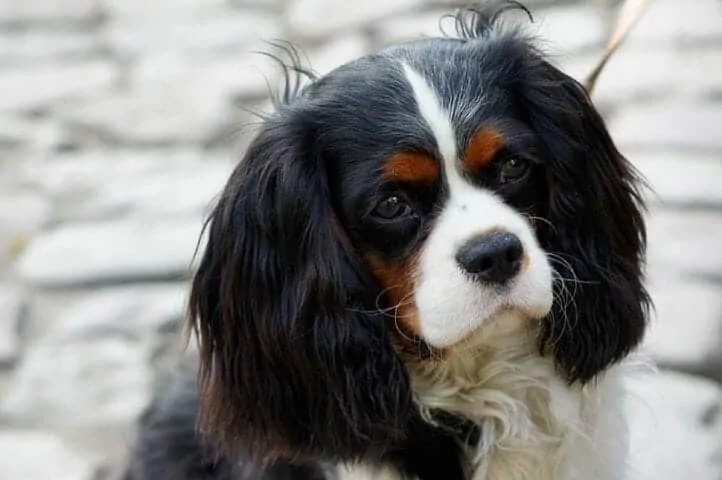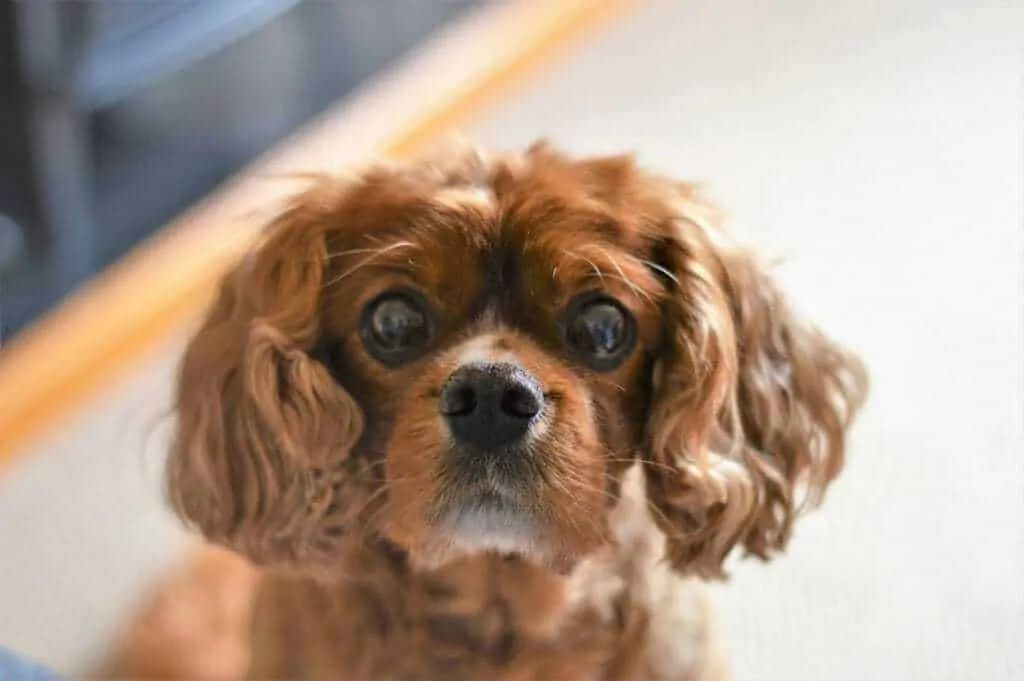The Cavalier King Charles Spaniel is one of the most popular Toy Breeds in the world, and with good reason: with their meltingly sweet expressions; even tempers; and tendency towards gentleness, Cavalier King Charles Spaniels can make the ideal family pet.
Standing between 12 and 13 inches, the Cavalier King Charles Spaniel is the tallest of the Toy Breeds. With their silky coat, and characteristic feathering across their legs, the American Kennel club recognize four coat patterns: Blenheim, a pretty mixture of red and white; Ruby, a solid rich red; Black and Tan; and Tricolour, a mix of black, tan, and white.
Weighing in at between 13-18 pounds, they are the perfect size to cuddle up with on the sofa, whilst their sturdiness prevents the delicateness associated with many of the Toy breeds. The American Kennel Club characterises Cavalier King Charles Spaniel as an ‘active, graceful, well-balanced toy spaniel, very gay and free in action; fearless and sporting in character, yet at the same time gentle and affectionate’. And who could fail to love a dog with these qualities?
Although smaller than sporting breeds of spaniel (like the similarly popular Cocker and Springer Spaniels), they retain much of the spaniel physiology. Because of their sporting character, they tow-the-line between lap-dog and active companion. They love nothing more than being with their humans, being equally happy to curl up with you on the sofa, and to join their human family on a hike.
Contents
A breed with a long history
Our modern-day Cavalier King Charles Spaniels can trace their origin to the Toy spaniels, popular amongst members of the European nobility from at least the 16th century. These Toy spaniels, who share a close resemblance to our modern-day Cavaliers, are immortalized in many paintings from this time period, right up until to the 19th century.
Bred as companion dogs, and to warm the laps of their owners, these small spaniels enjoyed great popularity amongst the nobility of Britain. A Toy spaniel was even rumored to have been found, nestled amongst Mary Queen of Scots petticoats, after her beheading.
They gained the regal name ‘King Charles Spaniel’, from King Charles II, a 17th-century British monarch who, along with his father, had a great love of the Toy spaniel. In fact, he was rarely seen without one or more of the breed around his ankles.
These early ‘King Charles’ spaniels remained popular well into the 19th century. During the reign of Queen Victoria, the Toy spaniel was crossed with the newly fashionable Asian toys, most probably Pugs and the Pekinese. These new Toy spaniels had a flatter face than the traditional King Charles Spaniel, their eyes were more pronounced, and their skulls were domed.
Despite the deviation from tradition, it is the Victorian version of the Toy spaniel that carries the name ‘King Charles Spaniel’ in the UK. However, the Victorian variation is now known as the ‘English Toy Spaniel’ in America.
For a time, it was the new Pug- style King Charles Spaniel that reigned supreme in popularity, and the traditional looks of the Toy spaniel could have been lost forever.
The return of the traditional King Charles Spaniel
However, In the 1920s, an American gentleman called Rosewell Eldridge became fascinated with the Toy spaniels he saw in portraits. He offered a cash incentive to any English breeder who could recreate this iconic breed, to match the images he saw in paintings. The promise of a cash prize proved a great motivator, and dogs matching the old-style Toy spaniel, free from the Pug like domed head and bulbous eyes, were soon produced.
This created an issue, how could this new, ‘old style’ King Charles Spaniel be differentiated from its cousin, the English Toy spaniel? Remember, these dogs were, and still are, known as ’King Charles Spaniels’ in the UK. To limit confusion, Eldridge’s ‘old style’ spaniels were named: Cavalier King Charles Spaniels.
Cavalier King Charles Spaniels quickly gained popularity, and they have continued to enjoy popularity, both in show circuits and family homes, ever since.
The Cavalier King Charles Spaniel at a glance:
| Other Names: | Cavi; Cav; Cavalier |
| Dog Breed Group: | Toy |
| Height: | 12-13 inches |
| Weight: | 13-18 pounds |
| Life Span: | 12-15 years |
| Suitable for First Time Dog Owners? | Yes |
| Temperament: | Even-tempered; friendly; gentle; eager to please |
| Can be left alone? | For short periods of time (maximum: 4 hours) |
| Barking Tendencies: | Medium- although not yappy they can be quick to alert their owners to visitors or unusual noises |
| Apartment Friendly? | Yes, if given adequate walks |
| Cat-Friendly? | Yes, if socialized from puppyhood |
| Dog-Friendly? | Yes, if socialized (whilst aggression is unusual, Cavs may exhibit fearful behavior if not properly socialized) |
| Child-Friendly? | Very, if socialized (whilst aggression is unusual, Cavs may exhibit fearful behavior if not properly socialized) |
| Stranger-Friendly? | If socialized (whilst aggression is unusual, Cavs may exhibit fearful behavior if not properly socialized) |
| Nutrition | Cavaliers should be fed with high-quality food matched to their age |
| Grooming | Regular brushing (minimum once per week), optional coat trimming |
| Shedding Level | Medium (expect to clear fur from furniture often!) |
| Exercise Needs | 30 minutes- 1 hour per day |
| Trainability | Average |
| Known Health Conditions | Mitral Valve Disease (MVD)
Congenital Keratoconjunctivitis Sicca and Ichthyosiform Dermatosis |
Still reading? Fantastic! Here are eleven things you should know about the Cavalier King Charles Spaniel:
1. There are only two breeds of Toy spaniel in the world:
The Cavalier King Charles Spaniel and the English Toy spaniel are the only breeds of Toy spaniel in existence. Part of the spaniel family, these pint-size companions share lineage with a wide variety of sporting dogs, like the English and American Cockers; Springers; Clumber; Sussex; Brittany; and Field Spaniels.
As a Toy breed, Cavaliers are smaller and less adept at hunting and retrieving than their bigger cousins, but they do retain some of the spaniel hunting spirit. This means that Cavaliers are often tempted to chase birds and small furriers. In fact, some Cavs will chase anything that moves! My childhood Cavalier, a Black and Tan beauty named Tilly, would even try to chase cars, if she was given the opportunity.
To prevent your Cavalier from becoming lost, or from running into danger, they should be carefully supervised on walks, and their yards should be secure. Many owners opt to keep their Cavalier Leashed, and a fantastic range of extendable leashes can be found online. If you prefer to exercise your Cavalier off-leash, care should be taken to find safe areas away from busy roads, and your Cav should be taught recall from a young age.
2. Cavalier King Charles Spaniels are great with children:
Cavalier King Charles Spaniels are usually fantastic with children, providing they are well socialized. In fact, even if a Cavalier is poorly socialized, he or she is more likely to run away from children, than to display aggressive behavior towards them.
Many Cavaliers will actively seek out children to cuddle and play with. My own Cavalier is a bit of a celebrity in the local neighborhood, many children know him by name, and he gets super excited when he sees them on his walks. For most Cavaliers, extra cuddles are a bonus in any situation!
Whilst this characteristic lack of aggression makes the Cavalier a good option for families, it is important to supervise any dog whilst they are around children. Every dog, regardless of breed, is an individual, and dogs and young children should never be left alone together. Despite breed characteristics, it impossible to predict how any individual dog will react in every situation (much like people!).
Supervision is also important to ensure that your Cavalier doesn’t become stressed by the children in your life. Too much rough housing can hurt or scare your Cavalier, and small children don’t always know their own strength. Children should be taught to respect their canine friends, and all dogs should have a safe space to which they can retreat when they want a break from noise and attention- a crate works particularly well for this purpose, especially if it is covered with a blanket to make it extra cozy.
3. In Fact, Cavalier King Charles Spaniels are incredibly people-friendly- full stop:
You know how some dogs are incredibly loyal and stick to their owner’s sides like Velcro, no matter who else is around? Yeah, Cavaliers don’t usually do this.
Confident by nature, most Cavaliers welcome all visitors like long-lost friends. When visitors arrive, it is common for Cavaliers to seize the opportunity for a new source of affection, sometimes even ignoring their family in favor of their visitor.
Though this undoubtedly has its benefits, after all, who doesn’t like a friendly dog? It also has its drawbacks. If you are looking for a guard-dog, the Cavalier is simply not the right breed for you, they are much more likely to lick an intruder than protect your household.
Because of their friendliness, it is advisable that you train your Cavalier not to greet guests too enthusiastically. Simple training can go a long way towards protecting against some awkward encounters, especially if you can train your Cav not to jump up and lick guests.
4. Cavaliers are basically baby wolves:
This research found that Cavalier King Charles Spaniels display the fewest wolf-like behavior markers, of any of the dog breeds studied. Displaying only two of the fifteen markers, Cavaliers behave in a similar manner to wolf pups- never reaching wolf-like maturity.
5. Cavalier King Charles Spaniels have been bred to wag their tail- a lot!
Have you ever noticed that Cavalier King Charles Spaniels seem to wag their tails 24/7?
Well, this is no accident. A permanently wagging tail forms part of the Cavalier King Charles Spaniel breed classification, and this trait judged in canine competitions. Because of this, a wagging tail has been purposely bred into Cavaliers over time. In fact, the American Kennel Club says that their tails should be moving whenever they are! But don’t worry, when your Cavalier wags her tail at you, she *probably* just happy to see you.
6. Cavaliers are not just couch potatoes:
Although Cavalier King Charles Spaniels are a Toy Breed, they are more than capable of joining you on long walks, in fact, they generally love an opportunity to stretch their legs and take in some new smells.
Although they can get enough exercise from regular short walks, and runs around the yard, they are capable of walking many miles, depending on individual fitness. If you are unsure how far your Cavalier can manage in one go, speak to your vet for advice. It is usually best to increase the distance of walks gradually, rather than expecting a dog used to short walks around the block, to keep up on a five-mile trek.
So, whilst they may not be the best fitness buddy if you regularly run or trek long distances, they are perfect for the average active household.
7. Cavalier King Charles Spaniels have a tendency to become overweight:
Despite being capable of long walks, many Cavaliers become overweight as they get older.
Natural scavengers, they use their irresistible puppy dog eyes to beg for dog treats or a bite of whatever their human family is eating.
However, as adorable as their longing faces may be, it is best to limit the number of treats you give to your Cavalier. Being overweight contributes to many health conditions, from arthritis to diabetes. And perhaps most importantly, being overweight causes undue strain on your Cavaliers’ heart. If you are concerned that your Cavalier is overweight, a trip to the vet can help you to plan a healthier diet.
(p.s. always check that human food is suitable for dogs before sharing your food, many common human foods are poisonous to our pets!)
8. Cavaliers can are prone to suffering from ‘Separation Anxiety’:
Cavaliers are highly susceptible to ‘separation anxiety’. This means that they can become very upset if left alone.
Separation anxiety commonly results in; barking, whining, and crying for prolonged periods of time; destructive behavior, like chewing and scratching furniture; urinating and defecating; and displaying general fearful behaviors (e.g. panting, salivating, pacing).
No Cavalier should be left for long periods of time, they are social creatures who need their family to feel happy. However, a well-adjusted Cav can cope with being home alone for short periods of time.
To prevent separation anxiety, Cavaliers should be trained that being alone is not scary from an early age.
9. Cavaliers are susceptible to some nasty health conditions:
Whilst any dog can become unwell, certain breeds are at an increased risk of specific health conditions. For the lovely Cavalier King Charles Spaniel, the most concerning of these conditions are: Mitral Valve Disease (MVD) and Syringomyelia (SM):
- Mitral Valve Disease (MVD) is a progressive condition that affects the Mitral Valve in the heart, eventually resulting in heart failure. MVD is twenty times more prevalent in Cavaliers than the rest of the canine population.
Usually, the first symptom to present is a heart murmur. Murmurs can initially be mild, and they may not need immediate treatment. As the condition progresses, medication might be required in order to keep your Cavalier as healthy and happy as possible, for as long as possible.
It is recommended that Cavalier King Charles Spaniels have their hearts checked by a Vet at least once per year. If a heart murmur is detected, more regular check ups may be required.
- Syringomyelia (SM) results in the presence of fluid-filled cavities within the spinal cord in the neck, and can cause severe pain.
Diagnosable by an MRI scan, the severity of SM varies between dogs, with some appearing to suffer little pain, whilst others appear to suffer greatly.
10. Cavalier King Charles Spaniel puppies should only be bought from responsible breeders
Despite the possible health problems listed above, it’s not all doom and gloom. You can greatly increase your chance of welcoming a healthy Cavalier to your family by sourcing your puppy responsibly. This means:
- Never buying from a pet shop- Puppies sold in pet shops have rarely been bred responsibly, and have an increased likelihood of experiencing health problems throughout their lives.
- Always seeing your puppy with their Mom before bringing them home- Sometimes puppy farms will use family homes as a ‘front’ for their businesses. If you are not allowed to meet the Mom, it is possible that the breeder is actually a puppy farm. Remember, a responsible breeder will always let you see the pups with their Mom. If they refuse, walk away.
- Choosing a breeder who health tests their bitches, and uses health tested stud dogs- For Cavaliers, the parents should be MRI scanned yearly for MVD, and should also be tested for SM and Eye Conditions.
11. Contrary to popular belief, some Cavalier King Charles Spaniels do end up in shelters:
Many people assume that Cavalier King Charles Spaniels never end up as shelter dogs needing a new home. That’s simply not true. Unfortunately, like all breeds, some Cavaliers are abandoned or surrendered by their families, and for many different reasons.
Before you decide to buy a puppy, check with your local shelter to see if they have any Cavaliers awaiting a forever home. You may find your ideal family member! There are also breed specific organizations in many areas, committed to helping Cavalier King Charles Spaniels in need, to find their perfect family. Check here for a Cavalier breed rescue near you!
